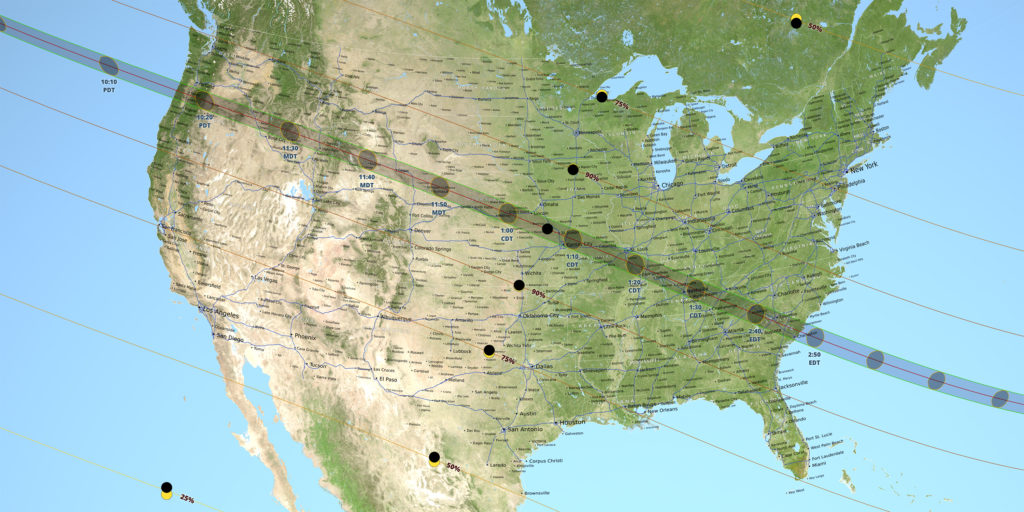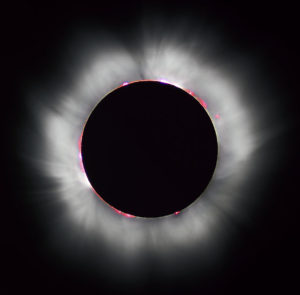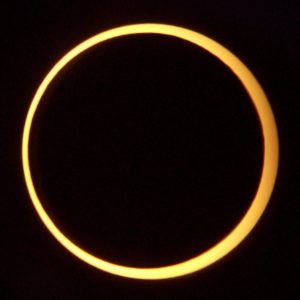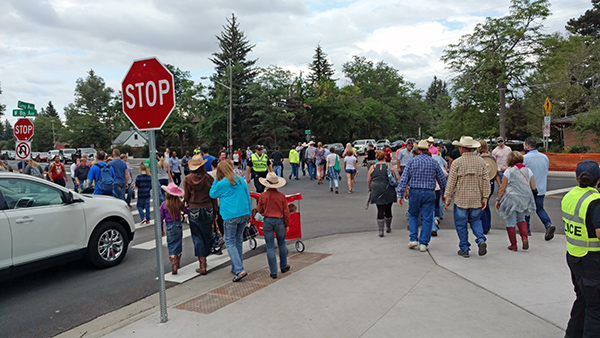Eclipse Traffic Congestion? Planning Provides Cure

Most metropolitan areas experience traffic congestion. Commuters endure hours of travel to get to their destinations, and traffic engineers work tirelessly to untangle those traffic tie-ups.
New construction, highway expansion, and public transit are all solutions to recurring congestion. But what about special events that may only draw commuting crowds once a year – or once every hundred years? Like a seasonal allergy, special-event traffic congestion can lead to stuffed-up travel lanes and headaches for communities.
Outlook for Monday: Severe Traffic Congestion
That 100-year flood of vehicles is what communities in 14 states across the United States will experience during the solar eclipse on August 21. It’s been almost 100 years – since June 8, 1918 – since a total solar eclipse crossed so much of the continental United States. Partial and lunar eclipses happen more frequently, but a total eclipse of the sun – especially occurring where so many people can see it – is a rare event indeed.
 While all of North America will experience a partial eclipse lasting two to three hours, “totality” will occur within an approximately 70-mile-wide path from Oregon to South Carolina. During the total eclipse, the moon completely blocks the sun’s face. The sky turns from day to night, and the solar corona – the sun’s outer atmosphere – will be visible for up to 2 minutes and 40 seconds.
While all of North America will experience a partial eclipse lasting two to three hours, “totality” will occur within an approximately 70-mile-wide path from Oregon to South Carolina. During the total eclipse, the moon completely blocks the sun’s face. The sky turns from day to night, and the solar corona – the sun’s outer atmosphere – will be visible for up to 2 minutes and 40 seconds.
Thousands – even hundreds of thousands – of scientists, students, meteorologists, eclipse chasers, and others from around the world will converge on sites within the path of totality. Many communities, emergency services, transportation experts, restaurants, and septic service and portable sanitation companies have been planning for years to provide locals and visitors alike a safe and unforgettable experience.
Wyoming Prepares for Eclipse Visitors
Wyoming is one of the states in the path of totality, with the centerline covering 365.7 miles of the state. Although our office in Cheyenne is outside totality, just 178 miles to the northwest, the city of Casper is in the line of totality, with the eclipse beginning there at 11:42:39 a.m. MDT and lasting 2 minutes and 26 seconds. Casper kicked off Wyoming Eclipse Festival 2017 today, with events planned up to the eclipse next Monday. As just one part of its eclipse traffic management, free park-and-ride shuttles are being provided into major event areas.
The Wyoming Department of Transportation has a link to construction projects active during the 2017 eclipse. Travel Wyoming also has an interactive map to help eclipse watchers pick just the right spot for viewing.
Safety First: Protect Your Eyes, Travel Safely
 No matter where you’re watching the eclipse, the first safety tip is to protect your eyes. Wear approved eclipse glasses or handheld solar viewers. Homemade filters or even dark sunglasses are not safe for looking at the sun. NASA has more tips for safe eclipse viewing.
No matter where you’re watching the eclipse, the first safety tip is to protect your eyes. Wear approved eclipse glasses or handheld solar viewers. Homemade filters or even dark sunglasses are not safe for looking at the sun. NASA has more tips for safe eclipse viewing.
And the second key to safe eclipse watching: Whether in the path of totality or just in partial eclipse range, travel safely. The Federal Highway Administration (FHWA) has these tips for safe travel during the solar eclipse:
- Don’t stop or park on the shoulder along the interstates or highways during the event.
- Exit the highway to a safe location to view the eclipse.
- Don’t take photographs while driving!
- Don’t try to wear opaque eclipse glasses while operating a vehicle.
- Turn your headlights on; do not rely on your automatic headlights when the eclipse blocks out the sun.
- Watch out for pedestrians along local roads. People may be randomly parking and walking alongside the roadside in the hours around the eclipse to get the best view.
- Prepare for extra congestion, especially on the interstates in the path of totality on the day before, day of, and day after the eclipse.
- Avoid travel during the eclipse or in the area of the main path if you can.
Wyoming Eclipse Festival organizers note that it’s very dry in Wyoming, and August is in the middle of fire season. Cars driving off the pavement risk starting a brush fire, which would certainly put a damper on eclipse viewing.
And About Those Human-Induced Traffic Events …
Another total solar eclipse of this magnitude won’t occur in the United States until April 8, 2024. But just next year the 122nd celebration of Cheyenne Frontier Days will attract thousands of visitors to this annual 10-day festival, billed as the World’s Largest Outdoor Rodeo and Western Celebration. Total attendance at the 2017 events was 534,510; the rest of the year Cheyenne’s population is just under 63,000. That’s quite a population spike!
With so many people in town for Frontier Days, there are bound to be traffic issues. We’re working with the Cheyenne Metropolitan Planning Organization (MPO) to complete a traffic study to address traffic congestion and parking concerns during Frontier Days. This study will address short-term improvements as well as outline a plan to address future traffic and parking planning as Frontier Days moves toward the vision outlined in a recently adopted master plan. The study will include traffic data collection, aerial photography of parking areas, and attendee interviews related to the park-and-ride system and pedestrian congestion at key locations.
We may not have all the solutions implemented by July 20-29, 2018, but future festivals will benefit from the MPO’s traffic management planning.

Most transportation planners for next week’s eclipse will likely never need to plan for another solar event, as the 2024 eclipse will follow a completely different path (from Texas through the northeast states). However, the paths of totality for the 2017 and 2024 eclipses intersect in Carbondale, Illinois. The traffic engineers in southern Illinois will probably start planning for the 2024 eclipse next Tuesday!

Post a comment: